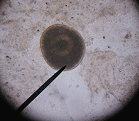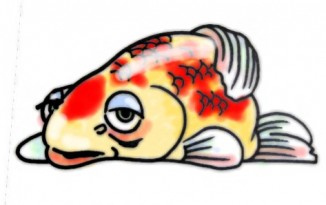ALL FISH DISEASE CASES ARE HANDLED IDENTICALLY. There are two reasons.
1. It is ILLEGAL for you to render a diagnosis or prescribe a treatment for people’s pet fish. This is the practice of veterinary medicine without a license. However, what you do in a pond maintenance capacity is entirely legal. So when you offer a “Pond Ecosystem Assessment” you can give the customer a clear document on the condition of the ecosystem, NOT their pets. And the information to them is just as useful! From this point forward, NEVER, EVER use the term “diagnosis” in print or in deed, ever AGAIN. From now on, you are “the man” for a Pond Ecosystem Assessment. (Assessment Form) BiologicalAssessementForm2007
2. The second reason that all fish disease cases are handled identically is so that you don’t forget anything, and so that if anything goes wrong, you can be defended in court. Yes,fish sometimes “just die” and people “just sue”. If you’ve followed a recommended step by step system of Pond Ecological Assessment, designed by a fish veterinarian, you have some credibility if anything were to happen. So let’s talk about the EXACT step by step assessment process.
My Fish Are Sick What Should I Do
So the customer calls you up and says they have fish showing signs of illness. Here’s the list of questions to ask them:
1. How big is the pond? (Gallons?)
2. How many inches of fish are in the pond?
3. How much / often are they fed?
4. Describe the waterchange interval and amount?
5. How does the water look to you?
6. What’s the temperature?
7. Has the pump been off for any reason? What does the pump normally flow?
8. Did you get new fish or plants?
9. Were those fish or plants kept in isolation / quarantine to prevent introduction of disease?
10. If so, what treatments were done in isolation?
11. What fish in the collection are affected? (Old or new fish?)
12. Have you tested your water quality?
13. What signs, marks, and symptoms do the fish show?
Here’s a nutshell of the answers you want from above. IF their answers ‘diverge’ from anything I am about to write, you have “something to go on” when you get out there to conduct your thorough, environmental and microbiological Pond Ecosystem Assessment.
Here’s a nutshell of the answers you want from above.
1,2: They should have no more than one inch of fish per ten gallons of pond water in the pond.
3. They should be feeding once or twice per day and NO food should be left after five minutes or they are overfeeding.
4. They should somehow be changing up to 40% of the pond’s volume every month whether in constant water change methods or interval changes of 10% per week. Topping off is not a water change!
5. Water should be clear and fresh smelling.
6. Temperature should be consistent, not changing any 20 degrees in 24 hours. Try and keep fish in the mid seventies.
7. If the pump cuts off at night in warm weather- large fish will die fast. The pump should turn over the whole pond every 1-2 hours at least.
8. IF they got new fish and plants, they could easily have gotten parasites, viruses or bacteria on those plants or fish.
9. IF the fish or plants were NOT quarantined – they introduced a disease.
10. IF no treatments were done in quarantine, they introduced a disease.
11. IF the new fish are sick and dying, the dealer may have sold them sick fish. If the old fish in the collection are dying, it may mean the resident fish are more vulnerable to the new fishes’ diseases which they may be more used to.
12. They should have tested water quality and found results in the following ranges:
- Ammonia – ZERO
- Nitrite – ZERO
- Nitrate – Less than 80 ppm
- pH – Any number higher than 7.0 is okay
- Carbonates: If tested, should be about 100-150 ppm
13. Signs and symptoms are ALMOST IRRELEVANT but should be asked. You are going to do ALL the same stuff at the edge of the pond whether the fish have sores, swollen eyes, clamped fins, or just loss of appetite.
When you go to the pond, your Pond Ecosystem Assessment starts and follows through these steps in this exact order:
1. Assess pond size.
2. Assess inches of fish per gallon.
3. See the food they feed, ask them to show you how much they feed, look for fish meal as the FIRST ingredient of any food being given to the fish. The food should come out of their refrigerator and not be mouldy or foul smelling as if overheated on the porch.
4. Assess water change interval, educate on CWIC method or 20% every two weeks whichever is easier.
5. Assess water quality to your eye, does it look swimmable, drinkable? It should.
6. Check the temperature against what they may have told you on the phone.
7. Look at pump flows and make sure the pump provides a current for the fish to swim in and surface agitation for oxygenation purposes.
8. Assess their new fish and see their facilities for quarantine. IF they don’t have quarantine facilities emphasize the FUTURE importance of quarantine so this doesn’t have to happen again.
9. Collect a water sample and check it for Ammonia, Nitrite, Nitrate, pH and Alkalinity. If you’re concerned, or they are, check for Hydrogen Sulfide (HACH.com – Sulfide kit – $34)
10. Examine fish grossly, Take digital images to send to a fish specialist. This may impress some customers.

11. Examine biopsies taken from the fish under your portable microscope. Write down any parasites observed. There are only five common “bugs” worth knowing which are, Ich, Chilodonella, Costia, Trichodina and Flukes.
Document the assessment of the pond including the fish measurements and stocking density and organisms
IF you see signs of bacterial infection, tell the customer “BACTERIA DO NOT CAUSE BACTERIAL INFECTIONS – Fish are made VULNERABLE to bacterial infections by water quality, crowding, wintertime chillling, infrequent pond cleaning, and parasites – and these issues are to be corrected before any success with the bacterial issues is possible. Document (a simple list) any parasites observed on the fish (not a diagnosis!!!) BiologicalAssessementForm2007
Provide the documentation to the customer. When they say ‘How do I treat?” The answer is simple, break out a copy of Koi Health and Disease 2 Reload. Sell this book to them because it has ALL the bugs and ALL the treatments and MORE in it – and tell them to use the index to look up the parasites in the assessment and follow those instructions. IF they need any of the medications mentioned, they can buy them from you but you’re not prescribing.
Be sure to have the medications listed in the book on hand and be ready to provide them to the customer.
The basics in your pond / fish disease tool kit include:
1. An anti parasite remedy for use in the pond water that contains Praziquantel (For flukes)
2. Salt for ciliated protozoan parasites like Ich, Chilodinella, Costia and Trichodina.
3. Formalin-containing compounds if the salt doesn’t work (remove most of the salt first)
4. A chitin synthesis inhibtor like Anchor & Lice Control for Fish Lice and Anchor Worm
5. Medicated food for bacterial infections. (No longer available anywhere)
6. Sometimes the ability to heat a very weak fish in a small quarantine facility will save these weak fish. So having a collapsible tank that you can loan or rent them then sterilize later is nice, with a titanium caged drop in heater.
Thermostat https://amzn.to/34JcS3q
Heater https://amzn.to/2Nv8tLv
There’s so much to know about fish health, A GREAT DEAL of this information is available in Koi Health and Disease 2006 Reload.
The point of this article is that if you proceed through a disease case in a haphazard or random way – the results could bite you in the butt. If you proceed in a uniform, orderly and educated way, you will seldom miss anything – and you will be positioned for success. Or, if you’re striking out anyway – at LEAST you will have an intelligent workup to hand to me if you need me to help.
It’s easier to learn about fish health BEFORE you need it. It’s easier to learn “Stop Drop and Roll” before you’re on fire.






